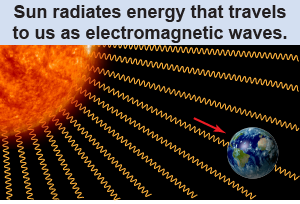|
 The Sun’s radiant energy travels to the Earth in the form of electromagnetic waves over a wide band of frequencies. The majority of the Sun’s radiation energy is in the form of infrared, visible, and ultraviolet light. The total power is 1368 W on every square meter of the side of the Earth facing the Sun. The total solar power received by Earth is 1.2×1017 W or 120,000 TW. By comparison, the total power consumed by humans is about 15 TW.
The Sun’s radiant energy travels to the Earth in the form of electromagnetic waves over a wide band of frequencies. The majority of the Sun’s radiation energy is in the form of infrared, visible, and ultraviolet light. The total power is 1368 W on every square meter of the side of the Earth facing the Sun. The total solar power received by Earth is 1.2×1017 W or 120,000 TW. By comparison, the total power consumed by humans is about 15 TW. 
|
How much energy is in just one of the frequencies present in the Sun’s radiation? The relation between frequency and energy is given by the Planck relation, equation (22.3). 
|
| (22.3) | | | E | = | photon energy (J) | | h | = | Planck constant = 6.63×10−34 J s | | f | = | frequency (Hz) |
| Planck relation for the
energy of light
|
|
The constant of proportionality is called Planck’s constant, named after the German physicist Max Planck, who inferred its properties in 1900. Planck’s constant connects the energy of electromagnetic radiation to its frequency. Its value is 6.63×10−34 J s. 
 |
When Planck proposed his equation E = hf, he did not do so to explain the energy of individual photons or the quantum nature of light. His equation was part of his mathematical formalism to explain blackbody radiation, which you will learn more about in Chapter 24. Planck then used existing experimental data to calculate the value of his constant h. His value, published in a 1901 paper, was 6.55×10−27 erg s = 6.55×10-34 J s which is only 1.2% lower than the modern value. As part of Planck’s mathematical model, he was also able to calculate the value of Boltzmann’s constant as kB = 1.35×10−16 erg/K which is also only 1.2% lower than the modern value. 
|
Equation (22.3) might appear straightforward, but it actually represents a fundamental change in scientific thought! Planck’s relation describes a universe where light’s energy only comes in discrete packets called the photon. There is no bundle of light energy smaller than hf—all larger quantities of light energy are made up of whole number multiples of hf. When Planck—and later Albert Einstein—thought about light as being composed of little bundles of energy, they changed the way we think of light. 
|
You may have noticed that Planck’s constant is of the order of 10−34! The Planck equation affects matter and energy on the microscopic scale. A photon of visible light energy is a tiny quantity, appropriate to the size and energy of a single atom. The photon is an example of quantum physics. The word quantum means a physical quantity that occurs only in discrete units, or bundles. A photon is a quantum of light energy. A quantum cannot be divided. A single photon is the smallest possible quantity of light. You cannot have half of a photon or 1.5 photons. Light occurs in integer multiples of whole photons. You will learn about other quanta in Chapter 26! 
|
How many visible light photons of frequency f = 6×1014 Hz are there in 1 J of energy? | Asked: | number of photons in 1 J of energy | | Given: | frequency f = 6 × 1014 Hz; Planck’s constant h = 6.63 × 10−34 J s | | Relationships: | Planck relation E = hf | | Solution: | The energy of one photon of light (i.e., joules per photon) is The number of photons in 1 J (i.e., photons per joule) is the inverse: | | Answer: | There are 2.5×1018 photons of this frequency in 1 J of energy. | 
|
How much energy is there in one photon of red light, which has a wavelength of 7 × 10−7 m? - 4.6 × 10−40 J
- 2.8 × 10−33 J
- 4.6 × 10−19 J
- 2.8 × 10−19 J
 |
The correct answer is d, 2.8 × 10−19 J. First, use c = λf to find the frequency, and then use E = hf to find the energy. 
|

